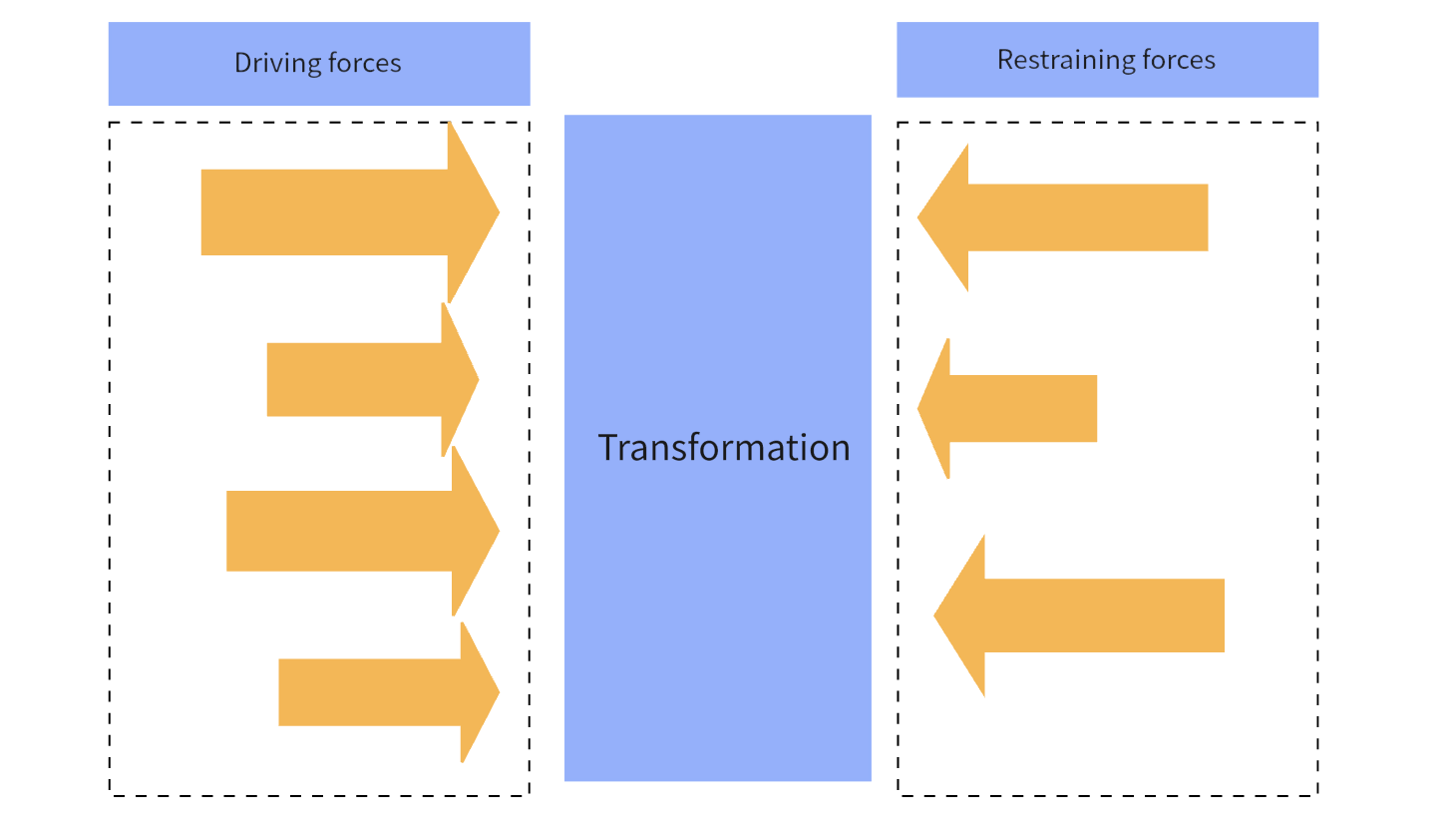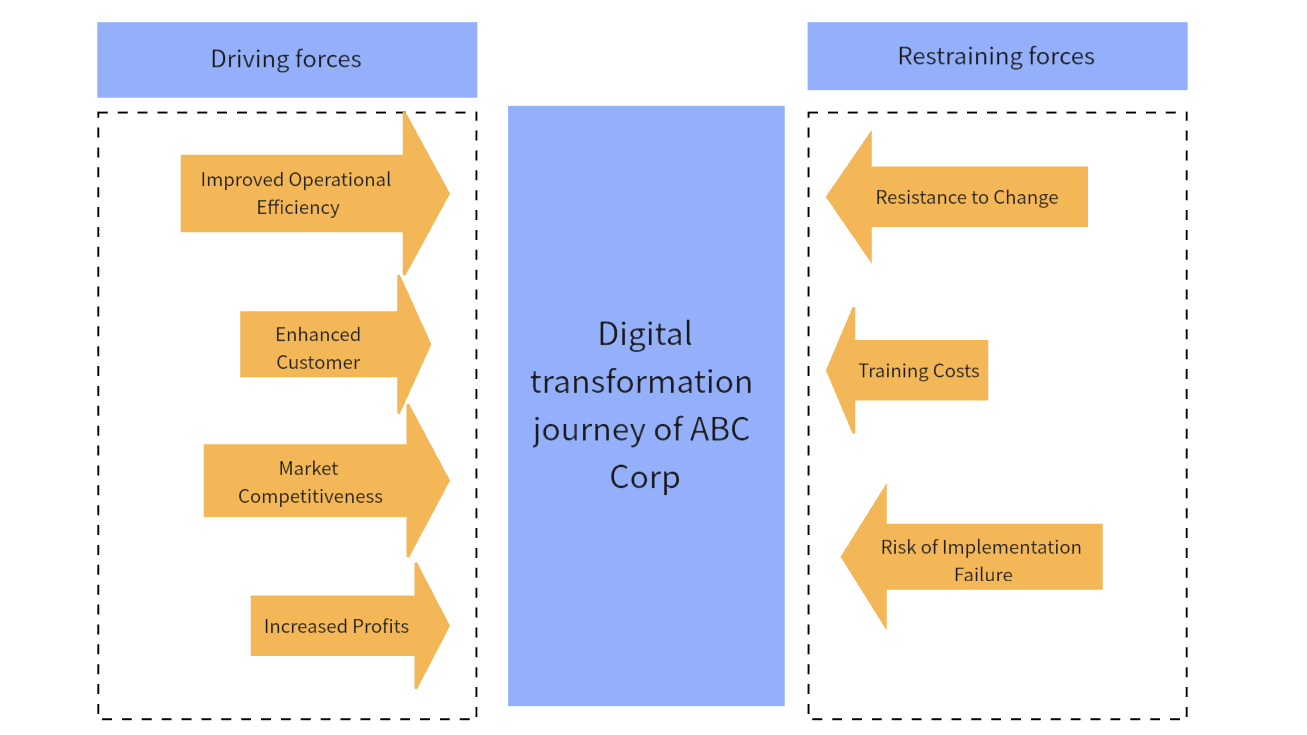In the ever-evolving world of business, companies continuously strive for change to maintain a competitive edge. However, managing and implementing change effectively can be a daunting task. This is where Force Field Analysis comes into play. As an invaluable tool, it assists businesses in understanding the dynamics of change and provides a structured method for implementing change strategies.
This guide will explain what Force Field Analysis is, outline its key elements and stages, introduce when to use it and how to perform it. Meanwhile, an example in real life will be analyzed for better understanding. Let’s dive in.
What Is Force Field Analysis
Force Field Analysis is a decision-making technique developed by social psychologist Kurt Lewin in the 1940s. The concept posits that every situation is maintained by forces pushing in opposing directions – driving forces pushing for change and restraining forces working against it. To achieve desired changes, driving forces must be strengthened or restraining forces weakened.

The application of Force Field Analysis in business involves assessing these forces, devising strategies to manage them, and ultimately creating conditions favorable for achieving desired changes. Its wide-ranging applications include problem-solving, decision making, planning, and conflict resolution.
4 Key Elements and 3 Stages of Force Field Analysis
Force Field Analysis comprises four key elements:
- Current Situation: This is the status quo that a business wishes to change. The current situation acts as the reference point from which all forces - either facilitating or inhibiting change - are identified.
- Driving Forces: These are the forces that promote or drive change. They could be internal, such as a new vision or strategy, or external, like changes in market trends or customer preferences.
- Restraining Forces: These are the forces resisting change. Just like driving forces, they could also be internal, such as staff resistance or lack of resources, or external, like regulatory constraints or competitive pressures.
- Desired State: This represents the change objective or the state that the business aims to achieve.
A typical Force Field Analysis consists of three stages:
- Identifying the Forces: First, all relevant driving and restraining forces affecting the situation are identified. This step requires comprehensive brainstorming and in-depth knowledge of the situation.
- Analyzing the Forces: The identified forces are then analyzed and prioritized based on their impact and influence on the situation. Tools like scoring systems can help quantify the strength of each force.
- Developing a Strategy: Based on the force field analysis, a strategy is formulated. It involves strengthening driving forces, weakening restraining forces, or both, to shift the balance in favor of desired changes.
Force Field Analysis is an effective tool for facilitating successful changes in businesses. It provides an organized approach to manage the forces of change, thereby maximizing the chances of successful implementation and minimizing resistance to change.
When to Use Force Field Analysis
Force Field Analysis can be an effective instrument in various scenarios. Its application is not limited to any specific industry or scale of business, making it universally relevant. Here are a few situations where Force Field Analysis proves particularly useful:
Problem-Solving
Force Field Analysis can be employed when confronting complex problems. By clearly visualizing the forces driving and restraining progress, businesses can strategize more effectively to overcome obstacles and achieve solutions.
Decision-Making
When multiple potential options exist and a decision must be made, Force Field Analysis can help weigh the positive and negative implications of each alternative, facilitating more informed decisions.
Change Management
Force Field Analysis is integral during change management. It identifies internal and external forces that could either facilitate or hamper proposed changes, aiding in the development of strategies for effective change implementation.
Strategy Development
In the strategy development process, Force Field Analysis can help understand market dynamics, organizational capabilities, and potential hurdles, contributing to more robust and adaptable strategies.
Benefits of Force Field Analysis
The use of Force Field Analysis brings multiple benefits to an organization:
- Clearer Understanding of the Situation: By dissecting driving and restraining forces, Force Field Analysis presents a detailed picture of the situation at hand. This detailed understanding enables businesses to approach challenges more strategically.
- Informed Decision-Making: By providing a quantitative assessment of the forces at play, Force Field Analysis supports data-driven decision making, reducing risks and uncertainties.
- Enhanced Team Engagement: When performed as a group activity, Force Field Analysis promotes collaboration and encourages diverse perspectives, leading to better insights and stronger team alignment.
- Improved Change Management: Force Field Analysis allows businesses to foresee possible resistance to change and devise effective strategies to overcome these obstacles, leading to smoother change implementation.
- Continuous Improvement: Force Field Analysis can also act as an iterative process that organizations use for continuous improvement, consistently evaluating driving and restraining forces to ensure constant progress.
In conclusion, Force Field Analysis is a versatile tool offering considerable benefits in diverse business scenarios. From problem-solving to decision-making, strategy development to change management, Force Field Analysis can be a valuable addition to any business’s toolkit.
How to Conduct a Force Field Analysis in Boardmix
Force Field Analysis (FFA) is a powerful tool that allows businesses to visualize the forces that can drive or hinder change. Its application in Boardmix, an intuitive platform for board and management reporting, is exceptionally potent, enabling users to navigate complex situations and make strategic decisions effectively. This part will walk you through the process of conducting a Force Field Analysis in Boardmix.

Understanding Boardmix's Capabilities
Boardmix is an all-in-one platform designed to streamline and simplify board and management reporting. It offers several features that can facilitate a comprehensive Force Field Analysis, such as advanced data analytics powered by AI, interactive dashboards, real-time collaboration, and robust visualization tools.
Set up Your Force Field Analysis in Boardmix
To start conducting your Force Field Analysis, follow these steps:
- Define the Change: In Boardmix, create a new board dedicated to the change you're considering. Clearly define the current situation and the desired state you hope to achieve.
- Identify Forces: Next, initiate a brainstorming session with your team. Use the real-time collaboration feature to collectively identify all driving and restraining forces relevant to the change.
- Analyze Forces: Analyze each identified force, evaluate their potential impact and assign them scores based on their relative strength or influence on the proposed change.
- Visualize Forces: Make use of Boardmix's visualization tools to create a force field diagram. This visual representation will illustrate the balance between driving and restraining forces, giving stakeholders a clear snapshot of the situation.
Develop Strategies Using Force Field Analysis in Boardmix
Once your Force Field Analysis is complete, you can leverage the insights gleaned to formulate effective strategies:
- Review Results: Discuss the Force Field Analysis results with your team using Boardmix's interactive dashboards and video conferencing capabilities. Assess which forces are most critical to address.
- Formulate Strategies: Based on your discussions, devise strategies that strengthen driving forces, weaken restraining forces, or both. Use Boardmix to document these strategies and assign responsibilities.
- Monitor Progress: Continually monitor the progress of implemented strategies using Boardmix's advanced tracking features. If necessary, update your Force Field Analysis to reflect any changes in force dynamics.
Conducting a Force Field Analysis in Boardmix is a straightforward and interactive process that brings together diverse perspectives and robust analytics for effective decision-making. By leveraging Boardmix's capabilities for Force Field Analysis, businesses can navigate change more strategically, fostering a proactive culture of continuous improvement.
A Practical Example of Force Field Analysis
Force Field Analysis is a valuable tool in business decision-making and problem-solving. It helps to identify and analyze the forces driving or restraining change within an organization. In order to demonstrate its practical use, here is an example of Force Field Analysis applied to a fictitious company aiming to adopt digital transformation.

1. Scenario
ABC Corp is a traditional company that has been operating successfully for over three decades. However, in recent years, they've been facing intense competition from more technologically advanced rivals. To retain its market position, ABC Corp's management decides to undertake a digital transformation journey. However, before proceeding, they decide to conduct a Force Field Analysis to understand the forces that could affect this significant change.
2. Current Situation
ABC Corp is operating with outdated technology and manual processes, which are affecting efficiency and productivity.
3. Desired State
ABC Corp aims to fully adopt digital technologies in its operations to improve efficiency, productivity, and competitive edge.
4. Identify Forces
Driving Forces
- Improved Operational Efficiency: Digital transformation can automate manual tasks, leading to better efficiency.
- Enhanced Customer Experience: With new technology, ABC Corp can provide improved services and customer experiences.
- Market Competitiveness: Adopting digital transformation can give ABC Corp an edge over its competitors.
- Increased Profits: Improved efficiency and customer satisfaction can lead to increased revenue.
Restraining Forces
- Resistance to Change:Long-time employees may resist changes in operational processes.
- Training Costs: Training staff in new digital technologies would require significant investment.
- Risk of Implementation Failure: The risk of implementation failure is a common concern during substantial change.
5. Analyze Forces
The company now analyzes these forces by assigning them scores based on their impact and influence on the proposed change.
6. Implement Strategies
Having understood the key driving and restraining forces, ABC Corp then formulates strategies:
- To overcome resistance to change, they plan to involve employees early in the decision-making process.
- They allocate budget for training staff and hiring digital experts to minimize implementation risks.
- They also plan to implement changes gradually rather than all at once, thus allowing for adjustments and corrections along the way.
In this example, Force Field Analysis has helped ABC Corp understand the potential challenges and advantages of their proposed digital transformation. By carefully analyzing the driving and restraining forces, they have developed effective strategies that aim to maximize their success chances while minimizing potential risks.








